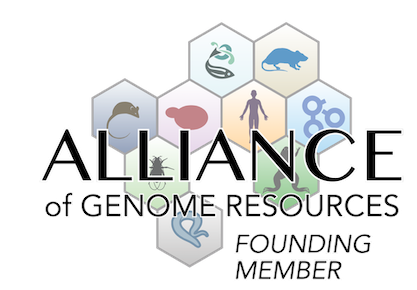growth/size/body
behavior/neurological
|
• gradually increase food intake
|
homeostasis/metabolism
|
• gradually increase plasma insulin levels over time
|
|
• males, but not females, show a moderate increase in cholesterol levels
|
|
• elevated in both males and females, although levels are higher in males than females
|
vision/eye
|
• arteriolar attenuation, venous dilation by 6 weeks
• severe retinal vessel attenuation and sheathing by 5 months
|
|
• granular appearance by 6 weeks
• focal and diffuse loss of pigment epithelium by 5 months
|
|
• reduced and disorganized nuclear layer by 3 weeks
|
|
• a progressive loss of outer nuclear layers
|
|
• contains at most one-third of thickness of cell in this layer compared to normal mice
|
|
• no photoreceptors were present by 8 months
|
|
• are attenuated
|
|
• normal organized photoreceptor cell outer segments are not observed at any time
• composed of membranous whirls arranged in an irregular configuration
|
|
• largely degenerated
|
|
• a progressive loss of the photoreceptors
|
|
• develop progressive retinal degeneration
(J:32415)
• pyknotic photoreceptor cell nuclei are observed throughout the first 15 weeks
(J:121993)
• rate of photoreceptor loss was constant and both cone and rod photoreceptor cells are degenerated at equal pace
(J:121993)
• the rate of degeneration was similar in both the peripheral and central region
(J:121993)
• only one to two layers of photoreceptor cell nuclei remained at 15-16 postnatal weeks
(J:121993)
• degenerative changes within the inner retina were not observed during first 15 postnatal weeks
(J:121993)
|
|
• patches of pigment deposits by 5 months
|
|
• the electroretinogram in homozygous mutant is never normal
• the waves are poorly developed and have reduced amplitudes compared to normal controls in the higher intensity waveforms
• with lower intensity flashes, the electroretinography exhibited lower amplitudes
• the amplitude loss was progressive and the electroretinogram was extinguished by 6 months
|
hearing/vestibular/ear
|
• at the basal end of the cochlea the osseous spiral lamina is partly empty, indicating loss of the afferent processes of the spiral ganglion cells
|
|
• a severely degenerated organ of Corti; no hair cells or supporting cells are identifiable
|
|
• apparent by 6 postnatal months
|
|
• only the innermost row of outer hair cells is seen, suggesting a partial loss of outer hair cells
(J:26067)
• any reduction in the number of outer hair cells in the apical half of mutant cochlea at 5-6 months of age is modest
(J:26067)
• apparent by 6 postnatal months
(J:121993)
|
|
• a severely degenerated organ of Corti; no hair cells or supporting cells are identifiable
(J:26067)
• degeneration of phalangeal and other support cells was also observed
(J:121993)
|
|
• a degeneration of organ of Corti in the basal end of the cochlea
• the transition from a well organized organ of Corti with at least a partial complement of inner and outer hair cells, to a mass of undifferentiated cells occurred in the lower basal turn
• apical half of the cochlea are normal with preservation of hair cells, supporting cells, and afferent dendrites
• the features of Reissner's membrane, stria vascularis, and the density of nerve fibers within the modiolus are normal
• Rosenthal's canal, is similar in appearance in all turns
• neither behavioral nor structural evidence of vestibular abnormalities
|
|
• some homozygous mutants showed elevated ABR thresholds to clicks and 32-kHz pips at 3 weeks of age
• at 7, 9, and 12 weeks of age, homozygous mutant mice exhibited 20- to 30-dB higher ABR thresholds across all stimuli at click, 8 kHz, 16 kHz, and 32 kHz
|
|
• progressive hearing loss, so that by 5-6 months of age, virtually deaf at 90-100 dB
(J:121993)
|
nervous system
|
• a severely degenerated organ of Corti; no hair cells or supporting cells are identifiable
|
|
• apparent by 6 postnatal months
|
|
• only the innermost row of outer hair cells is seen, suggesting a partial loss of outer hair cells
(J:26067)
• any reduction in the number of outer hair cells in the apical half of mutant cochlea at 5-6 months of age is modest
(J:26067)
• apparent by 6 postnatal months
(J:121993)
|
|
• no photoreceptors were present by 8 months
|
|
• are attenuated
|
|
• normal organized photoreceptor cell outer segments are not observed at any time
• composed of membranous whirls arranged in an irregular configuration
|
|
• largely degenerated
|
|
• a progressive loss of the photoreceptors
|
|
• at the basal end of the cochlea the osseous spiral lamina is partly empty, indicating loss of the afferent processes of the spiral ganglion cells
• spiral ganglion cell bodies in Rosenthal's canal in the most basal half turn were lost in some cochlea
|
pigmentation
|
• granular appearance by 6 weeks
• focal and diffuse loss of pigment epithelium by 5 months
|
cardiovascular system
|
• arteriolar attenuation, venous dilation by 6 weeks
• severe retinal vessel attenuation and sheathing by 5 months
|
skeleton
|
• at the basal end of the cochlea the osseous spiral lamina is partly empty, indicating loss of the afferent processes of the spiral ganglion cells
|
craniofacial
|
• at the basal end of the cochlea the osseous spiral lamina is partly empty, indicating loss of the afferent processes of the spiral ganglion cells
|
Mouse Models of Human Disease |
DO ID | OMIM ID(s) | Ref(s) | |
| obesity | DOID:9970 |
OMIM:601665 |
J:32415 | |



 Analysis Tools
Analysis Tools